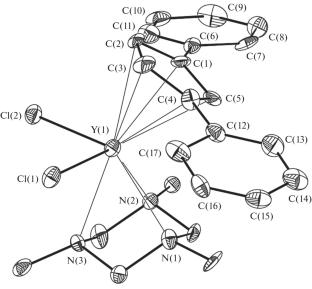与1,3,5-三甲基-1,3,5-三氮杂环己烷的钇聚苯基环戊二烯配合物
IF 1.1
3区 化学
Q4 CHEMISTRY, INORGANIC & NUCLEAR
引用次数: 0
摘要
二、三、四苯基环戊二烯钾与氯化四氢呋喃酸钇在1,3,5-三甲基-1,3,5-三氮杂环己烷(Me3tach)存在下反应得到[Cp' y (Me3tach)Cl2] (Cp' = Ph2C5H3 (CpPh2) (I), Ph3C5H2 (CpPh3) (II), Ph4C5H (CpPh4) (III))。通过x射线衍射确定了配合物I - III的分子结构(CCDC编号2406644 (I), 2406645 (II), 2406646 (III))。与环戊二烯配体中苯基取代基的数量无关,所有得到的单环戊二烯配合物的主要结构参数相似。根据核磁共振光谱数据,化合物I和III在THF溶液中保持其结构。本文章由计算机程序翻译,如有差异,请以英文原文为准。

Yttrium Polyphenylcyclopentadienyl Complexes with 1,3,5-Trimethyl-1,3,5-triazacyclohexane
The reaction of di-, tri-, and tetraphenylcyclopentadienylpotassium with yttrium chloride tetrahydrofuranate in the presence of 1,3,5-trimethyl-1,3,5-triazacyclohexane (Me3tach) gives complexes of the type [Cp'Y(Me3tach)Cl2] (Cp' = Ph2C5H3 (CpPh2) (I), Ph3C5H2 (CpPh3) (II), Ph4C5H (CpPh4) (III). The molecular structure of complexes I–III was established by X-ray diffraction (CCDC nos. 2406644 (I), 2406645 (II), 2406646 (III)). The main structural parameters of all of the obtained monocyclopentadienyl complexes were similar, irrespective of the number of phenyl substituents in the cyclopentadienyl ligand. According to NMR spectroscopy data, compounds I and III retained their structure in THF solution.
求助全文
通过发布文献求助,成功后即可免费获取论文全文。
去求助
来源期刊

Russian Journal of Coordination Chemistry
化学-无机化学与核化学
CiteScore
2.40
自引率
15.80%
发文量
85
审稿时长
7.2 months
期刊介绍:
Russian Journal of Coordination Chemistry is a journal that publishes reviews, original papers, and short communications on all aspects of theoretical and experimental coordination chemistry. Modern coordination chemistry is an interdisciplinary science that makes a bridge between inorganic, organic, physical, analytical, and biological chemistry.
 求助内容:
求助内容: 应助结果提醒方式:
应助结果提醒方式:


